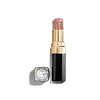Lisa Eldridge Baume Embrace Melting Lip Colour Versus Chanel Rouge Coco Flash Hydrating Vibrant Shine Lip Colour
What's inside
What's inside
 Key Ingredients
Key Ingredients

 Benefits
Benefits

 Concerns
Concerns

 Ingredients Side-by-side
Ingredients Side-by-side

Polyglyceryl-2 Triisostearate
EmulsifyingPolyglyceryl-6 Polyricinoleate
EmulsifyingOctyldodecanol
EmollientBis-Diglyceryl Polyacyladipate-2
EmollientPolyglyceryl-3 Diisostearate
EmulsifyingEuphorbia Cerifera Wax
Vp/Eicosene Copolymer
Synthetic Wax
AbrasiveSimmondsia Chinensis Seed Oil
EmollientAroma
Ethylene/Propylene Copolymer
AbrasiveLimnanthes Alba Seed Oil
Skin ConditioningDicalcium Phosphate
AbrasiveAstrocaryum Murumuru Seed Butter
EmollientPunica Granatum Flower Extract
Skin ConditioningPentaerythrityl Tetra-Di-T-Butyl Hydroxyhydrocinnamate
AntioxidantButyrospermum Parkii Butter Extract
Skin ConditioningIrvingia Gabonensis Kernel Butter
Skin ConditioningHydrogenated Coco-Glycerides
EmollientDisteardimonium Hectorite
StabilisingPolyhydroxystearic Acid
EmulsifyingIron Oxides
CI 77891
Cosmetic ColorantCI 15850
Cosmetic ColorantCI 42090
Cosmetic ColorantPolyglyceryl-2 Triisostearate, Polyglyceryl-6 Polyricinoleate, Octyldodecanol, Bis-Diglyceryl Polyacyladipate-2, Polyglyceryl-3 Diisostearate, Euphorbia Cerifera Wax, Vp/Eicosene Copolymer, Synthetic Wax, Simmondsia Chinensis Seed Oil, Aroma, Ethylene/Propylene Copolymer, Limnanthes Alba Seed Oil, Dicalcium Phosphate, Astrocaryum Murumuru Seed Butter, Punica Granatum Flower Extract, Pentaerythrityl Tetra-Di-T-Butyl Hydroxyhydrocinnamate, Butyrospermum Parkii Butter Extract, Irvingia Gabonensis Kernel Butter, Hydrogenated Coco-Glycerides, Disteardimonium Hectorite, Polyhydroxystearic Acid, Iron Oxides, CI 77891, CI 15850, CI 42090
Diisostearyl Malate
EmollientSqualane
EmollientBis-Behenyl/Isostearyl/Phytosteryl Dimer Dilinoleyl Dimer Dilinoleate
EmollientPhytosteryl/Octyldodecyl Lauroyl Glutamate
Skin ConditioningHydrogenated Coconut Oil
EmollientCaprylic/Capric Triglyceride
MaskingSucrose Tetrastearate Triacetate
EmollientIsotridecyl Isononanoate
EmollientSynthetic Wax
AbrasivePentaerythrityl Tetraethylhexanoate
EmollientEthylene/Propylene Copolymer
AbrasiveSorbitan Isostearate
EmulsifyingMeadowfoam Delta-Lactone
Skin ConditioningLauryl PCA
HumectantSynthetic Fluorphlogopite
Tocopheryl Acetate
AntioxidantEthylhexyl Palmitate
EmollientJojoba Esters
EmollientParfum
MaskingPolyglycerin-3
HumectantTribehenin
EmollientAlumina
AbrasiveDimethicone
EmollientPEG-8
HumectantTocopherol
AntioxidantAcacia Decurrens Flower Wax
EmollientHelianthus Annuus Seed Wax
Skin ConditioningSilica
AbrasiveAscorbyl Palmitate
AntioxidantAscorbic Acid
AntioxidantCitric Acid
BufferingPalmitoyl Tripeptide-1
Skin ConditioningCI 12085
Cosmetic ColorantCI 15850
Cosmetic ColorantCI 15985
Cosmetic ColorantCI 17200
Cosmetic ColorantCI 19140
Cosmetic ColorantCI 42090
Cosmetic ColorantCI 45380
Cosmetic ColorantCI 45410
Cosmetic ColorantCI 73360
Cosmetic ColorantCI 75470
Cosmetic ColorantCI 77163
Cosmetic ColorantCI 77491
Cosmetic ColorantCI 77492
Cosmetic ColorantCI 77499
Cosmetic ColorantCI 77742
Cosmetic ColorantCI 77891
Cosmetic ColorantMica
Cosmetic ColorantDiisostearyl Malate, Squalane, Bis-Behenyl/Isostearyl/Phytosteryl Dimer Dilinoleyl Dimer Dilinoleate, Phytosteryl/Octyldodecyl Lauroyl Glutamate, Hydrogenated Coconut Oil, Caprylic/Capric Triglyceride, Sucrose Tetrastearate Triacetate, Isotridecyl Isononanoate, Synthetic Wax, Pentaerythrityl Tetraethylhexanoate, Ethylene/Propylene Copolymer, Sorbitan Isostearate, Meadowfoam Delta-Lactone, Lauryl PCA, Synthetic Fluorphlogopite, Tocopheryl Acetate, Ethylhexyl Palmitate, Jojoba Esters, Parfum, Polyglycerin-3, Tribehenin, Alumina, Dimethicone, PEG-8, Tocopherol, Acacia Decurrens Flower Wax, Helianthus Annuus Seed Wax, Silica, Ascorbyl Palmitate, Ascorbic Acid, Citric Acid, Palmitoyl Tripeptide-1, CI 12085, CI 15850, CI 15985, CI 17200, CI 19140, CI 42090, CI 45380, CI 45410, CI 73360, CI 75470, CI 77163, CI 77491, CI 77492, CI 77499, CI 77742, CI 77891, Mica
Ingredients Explained
These ingredients are found in both products.
Ingredients higher up in an ingredient list are typically present in a larger amount.
Ci 15850 is the pigment color red. It is an azo dye and created synthetically.
Azo dyes need to be thoroughly purified before use. This allows them to be more stable and longer-lasting.
This ingredient is common in foundations, lipsticks, and blushes. This color is described as brown/orangey red.
It has many secondary names such as Red 6 and Red 7. According to a manufacturer, Red 6 usually contains aluminum.
Learn more about CI 15850Ci 42090 is a synthetic dye created from petroleum. It is used to give a bright blue color to cosmetics, medicine, and food.
Ci 77891 is a white pigment from Titanium dioxide. It is naturally found in minerals such as rutile and ilmenite.
It's main function is to add a white color to cosmetics. It can also be mixed with other colors to create different shades.
Ci 77891 is commonly found in sunscreens due to its ability to block UV rays.
Learn more about CI 77891Ethylene/Propylene Copolymer is an exfoliant.
Synthetic Wax is created from fossil fuels such as natural gas. It is used to enhance texture, adjust pH, and as an occlusive.
It may also be used as an abrasive ingredient to exfoliate the skin.
Synthetic Wax may not be fungal acne safe.
Learn more about Synthetic Wax